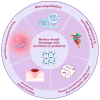Probiotics in Wound Healing
- PMID: 38891909
- PMCID: PMC11171735
- DOI: 10.3390/ijms25115723
Probiotics in Wound Healing
Abstract
Wound infections caused by opportunistic bacteria promote persistent infection and represent the main cause of delayed healing. Probiotics are acknowledged for their beneficial effects on the human body and could be utilized in the management of various diseases. They also possess the capacity to accelerate wound healing, due to their remarkable anti-pathogenic, antibiofilm, and immunomodulatory effects. Oral and topical probiotic formulations have shown promising openings in the field of dermatology, and there are various in vitro and in vivo models focusing on their healing mechanisms. Wound dressings embedded with prebiotics and probiotics are now prime candidates for designing wound healing therapeutic approaches to combat infections and to promote the healing process. The aim of this review is to conduct an extensive scientific literature review regarding the efficacy of oral and topical probiotics in wound management, as well as the potential of wound dressing embedding pre- and probiotics in stimulating the wound healing process.
Keywords: infection control; probiotic formulations; wound dressings; wound healing.
Conflict of interest statement
The authors declare no conflicts of interests.
Figures
Similar articles
-
Macro/Microgel-Encapsulated, Biofilm-Armored Living Probiotic Platform for Regenerating Bacteria-Infected Diabetic Wounds.Adv Healthc Mater. 2025 Mar;14(7):e2403476. doi: 10.1002/adhm.202403476. Epub 2025 Jan 20. Adv Healthc Mater. 2025. PMID: 39831829
-
Efficacy of Using Probiotics with Antagonistic Activity against Pathogens of Wound Infections: An Integrative Review of Literature.Biomed Res Int. 2019 Dec 12;2019:7585486. doi: 10.1155/2019/7585486. eCollection 2019. Biomed Res Int. 2019. PMID: 31915703 Free PMC article. Review.
-
Graphene Oxide/Copper Nanoderivatives-Modified Chitosan/Hyaluronic Acid Dressings for Facilitating Wound Healing in Infected Full-Thickness Skin Defects.Int J Nanomedicine. 2020 Oct 27;15:8231-8247. doi: 10.2147/IJN.S278631. eCollection 2020. Int J Nanomedicine. 2020. PMID: 33149572 Free PMC article.
-
Culture-Delivery Live Probiotics Dressing for Accelerated Infected Wound Healing.ACS Appl Mater Interfaces. 2023 Nov 22;15(46):53283-53296. doi: 10.1021/acsami.3c12845. Epub 2023 Nov 10. ACS Appl Mater Interfaces. 2023. PMID: 37948751
-
Wound care in venous ulcers.Phlebology. 2013 Mar;28 Suppl 1:79-85. doi: 10.1177/0268355513477015. Phlebology. 2013. PMID: 23482540 Review.
Cited by
-
A Preliminary Study of Intravaginal Lactic Acid Gel (Canesbalance®) for Post-Episiotomy Healing: A Randomized Clinical Trial.Healthcare (Basel). 2025 Jul 1;13(13):1581. doi: 10.3390/healthcare13131581. Healthcare (Basel). 2025. PMID: 40648604 Free PMC article.
-
The Role of Lactic Acid in Episiotomy Wound Healing: A Systematic Review.Healthcare (Basel). 2025 Apr 21;13(8):956. doi: 10.3390/healthcare13080956. Healthcare (Basel). 2025. PMID: 40281905 Free PMC article. Review.
-
The Effectiveness of Topical Lactic Acid Gel in Episiotomy Wound Healing and Its Impact on Sexual Quality of Life After Childbirth: A Prospective Study.Cureus. 2025 May 21;17(5):e84517. doi: 10.7759/cureus.84517. eCollection 2025 May. Cureus. 2025. PMID: 40400657 Free PMC article.
-
The relationship between the skin microbiome and probiotics in the healing of burn injuries.Folia Microbiol (Praha). 2025 Jun;70(3):535-544. doi: 10.1007/s12223-025-01262-8. Epub 2025 Apr 14. Folia Microbiol (Praha). 2025. PMID: 40227389 Review.
-
In vitro wound healing effects of postbiotics derived from the gut microbiota of long-lived blind mole rats, a model of healthy ageing.Wound Repair Regen. 2025 Mar-Apr;33(2):e70023. doi: 10.1111/wrr.70023. Wound Repair Regen. 2025. PMID: 40247718 Free PMC article.
References
-
- Schultz G.S., Chin G.A., Moldawer L., Diegelmann R.F. Principles of Wound Healing. In: Fitridge R., Thompson M.M., editors. Mechanisms of Vascular Disease: A Reference Book for Vascular Specialists. 1st ed. Volume 1. University of Adelaide Press; Adelaide, Australia: 2011. [(accessed on 20 April 2024)]. p. 23. Available online: https://www.ncbi.nlm.nih.gov/books/NBK534261/
Publication types
MeSH terms
LinkOut - more resources
Full Text Sources
Molecular Biology Databases



